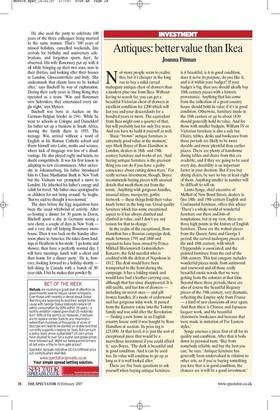Antiques: better value than Ikea
Joanna Pitman Not many people seem to realise this, but it's cheaper in the long run to buy a solid carved mahogany antique chest of drawers than a modern pine one from Ikea. Without having to search far, you can get a beautiful Victorian chest of drawers in excellent condition for £200 which will last you and your descendants for a hundred years or more. The equivalent from Ikea might cost a quarter of that, but will probably last for only five years. And you have to build it yourself as well.
'Basic "brown" antique furniture is extremely good value at the moment,' says Mark Boyce of Ross Hamilton in London, dealers in 18thand 19thcentury furniture and works of art. 'And buying antique furniture is the greenest thing you can do if you have a guilty conscience about cutting down trees.' For really serious investment, though, Boyce recommends buying pieces with unusual details that mark them out from the norm. 'Anything with gorgeous handles, unusual inlays, marquetry, gothic fretwork — these things hold their value much better in the long run. Good quality furniture which has some exceptional aspect to it has always climbed and climbed in value, and I don't see any reason for that to change.'
In the realm of the exceptional, Ross Hamilton has a Russian campaign desk, made between 1795 and 1800 and reputed to have been owned by Prince Mikhail Illarionovich GolenishchevKutuzov, the field marshal who is credited with the defeat of Napoleon in 1812. The desk would have been transported to the front during the campaign: it has a folding stand, and would have had a leather carrying case, although that has since disappeared. It is still usable, and has lots of drawers — including six secret ones — and gilt bronze handles. It's made of cedarwood and has gorgeous inlay work. It passed from the Kutuzov estate into the Tolstoy family and was sold after the Revolution — finding a new home in an English country house until it was bought by Ross Hamilton at auction. Its price tag is £25,000. At that level, it is 'just the sort of exceptional piece that would be a marvellous investment if you could afford it,' says Boyce. 'The desk is beautiful and in good condition. And it can be used too. Its value will continue to go up as long as it is well looked after.'
There are five basic questions to ask yourself when buying antique furniture: is it beautiful, is it in good condition, does it serve its purpose, do you like it, and is it within your budget? If your budget is big, then you should ideally buy 18th-century pieces with a historic provenance. Anything that has come from the collection of a great country house should hold its value if it's in good condition. Otherwise, furniture made in the 18th century or up to about 1830 should generally hold its value. And for those with smaller budgets, William IV or Victorian furniture is also a safe bet. Chairs, tables, desks and bookcases from these periods are likely to be more durable and more plentiful than earlier pieces. There are plenty of handsome dining tables and chairs from this era available, and if they are going to be used every day, durability is an important factor in your decision. But if you buy dining chairs, be sure to buy at least eight of them. Anything smaller in number will be difficult to sell on.
Lanto Synge, chief executive of Mallett of New Bond Street, dealers in fine 18thand 19th-century English and Continental furniture, offers this advice: 'There's a whole world of wonderful furniture out there and lots of temptations, but in my view, there are three high points in the history of English furniture. These are the walnut pieces from the Queen Anne and George I period; the carved mahogany pieces of the mid-18th century, with which Chippendale is associated; and the painted furniture from the end of the 18th century. This last category includes wonderful pieces made from satinwood and rosewood and all those really beautiful exotic woods that we were getting from the colonies at that time. Beyond these three periods, there are also of course the beautiful Regency pieces of the 19th century, very dramatic, reflecting the Empire style from France — a kind of neo-classicism all over again. And then there is Chinese and Japanese lacquer work, and the beautiful chinoiserie bookcases and bureaus that were made in imitation of Far Eastern styles.'
Synge assesses a piece first of all for its quality and condition. After that it boils down to personal taste. 'Buy from somebody reliable and buy the best you can,' he says. 'Antique furniture has generally been undervalued in relation to other arts, so if you're buying something you love that is in good condition, the chances are it will be a good investment.'













































 Previous page
Previous page